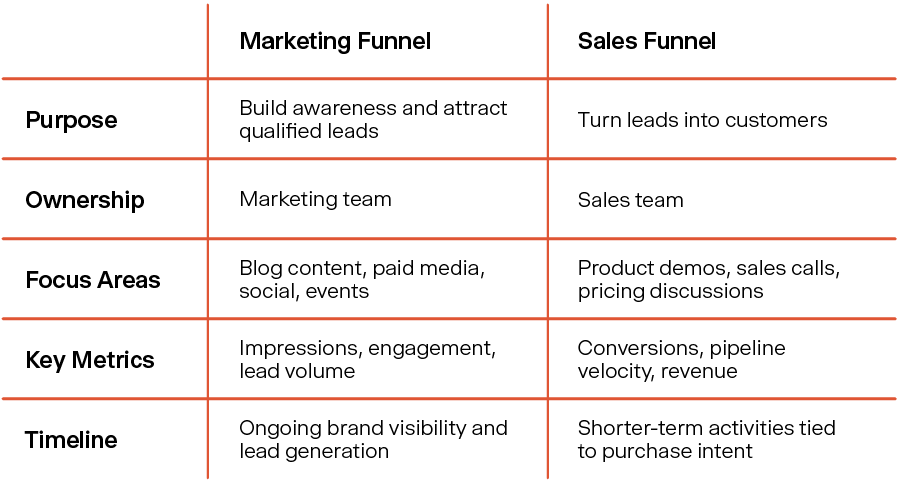Funnel Building: How to Align Strategy with Buyer Intent
Learn how to design sales funnels that match real user behavior — and how Simpli.fi helps you execute with precision.
Writer: Luis Reyes
Date: September 11, 2025
Funnel building gives advertisers a framework to align messaging, media, and measurement across the entire buyer journey. Instead of guessing what will move the needle, advertisers can map out how prospects think, act, and convert, then use that information to design campaigns that drive measurable outcomes.

This guide covers what a sales funnel is, why it matters in programmatic advertising, how to build one that performs, and how Simpli.fi supports each stage with precision targeting and full-funnel delivery.
WHY BUILDING A SALES FUNNEL MATTERS IN DIGITAL ADVERTISING
A well-built sales funnel gives advertisers the framework to connect strategy with outcomes. It helps teams understand where prospects are in their journey and what it takes to move them forward, making every campaign more intentional and measurable.
With this structure in place, advertisers can:
- Maximize return on ad spend (ROAS) by aligning media to buyer intent
- Lower acquisition costs through more focused targeting
- Improve conversion rates by guiding users through the right sequence of actions
- Increase customer lifetime value by staying relevant beyond the initial transaction
Creating funnels also drives stronger alignment between sales and marketing. When both teams work from a shared roadmap, it becomes easier to execute high-performing campaigns that scale.
WHAT IS A SALES FUNNEL?

A sales funnel outlines the customer journey from first touch to final conversion. The name reflects how a broad audience narrows as prospects move through each stage of the decision process.
Setting up a sales funnel means planning for each step of that journey. Content, channels, and calls to action should align with what users need, not just with how many impressions or clicks a campaign generates. Messaging that introduces your brand won’t work for someone ready to make a decision, and conversion tactics won’t land with a cold audience.
The funnel typically includes:
- Top of Funnel (TOFU): Capture attention from a broad audience
- Middle of Funnel (MOFU): Nurture leads through education and engagement
- Bottom of Funnel (BOFU): Convert qualified leads with personalized offers and tactics
SALES FUNNEL VS. MARKETING FUNNEL: WHAT’S THE DIFFERENCE
It’s common to see these two terms used interchangeably, but they serve distinct purposes. A marketing funnel drives awareness and generates leads. A sales funnel turns those leads into revenue. Understanding the handoff between the two helps teams coordinate efforts more effectively.
Overview of Marketing Funnel vs. Sales Funnel

When advertisers recognize the role each funnel plays, they can shape campaigns that support both acquisition and conversion without overlap or missed opportunities.
At Simpli.fi, we help clients connect these efforts to ensure that brand storytelling and performance marketing work in sync, from first impression to closed deal.
HOW TO BUILD A FUNNEL: A STEP-BY-STEP GUIDE

Whether you’re starting from scratch or refining an existing model, funnel building requires a thoughtful, audience-first approach. This step-by-step guide will help you develop a funnel that performs, powered by data, aligned with real intent, and focused on measurable outcomes.
Step 1 – Define Your Target Audience
Every successful funnel begins with a clear understanding of who you’re trying to reach. Use demographic data, behavioral signals, and intent insights to build precise audience segments.
Go beyond age and geography. Ask:
- What pain points does this audience face?
- Where do they spend time online?
- What motivates them to take action?
First-party data targeting capabilities allow advertisers to reach real people with precision, using real-time signals and location-based context to align messaging with behavior.
Step 2 – Map the Customer Journey
Once your audience is defined, map out their path from awareness to conversion. Identify key decision points, common objections, and where drop-offs occur.
This journey map becomes the foundation for content planning, channel selection, and measurement strategy. Ask:
- What questions do users have at each stage?
- Where do they engage—on social, mobile, or CTV?
- What does success look like at each step?
A strong journey map helps you meet users with the right message at the right time.
Step 3 – Create Content and Ads for Each Funnel Stage
Content should reflect how people make decisions, not just how they’re categorized.
- Top of Funnel (TOFU): Introduce your brand with content that builds awareness. Educational blog posts, explainer videos, and broad-reach DOOH advertising or social media advertising are effective ways to spark interest.
- Middle of Funnel (MOFU): As leads evaluate their options, offer information that builds credibility. Case studies, webinars, and product content work well when delivered through native ads or video formats.
- Bottom of Funnel (BOFU): This stage is all about conversion. Use CTV and mobile ads to deliver personalized offers, demos, or free trials to users who have shown interest. Retargeting helps reinforce trust and close the loop.
Each stage should build on the one before it, moving users closer to a decision with relevant, timely messaging.
Step 4 – Choose the Right Marketing Channels
Channel selection should be driven by where your audience is in the funnel and what they need at that stage.
- Use display and social for awareness campaigns. These platforms offer wide reach and allow you to filter by geography or behavior.
- Choose native and video for the consideration phase. These formats support deeper messaging that educates and informs.
- Leverage CTV and mobile when it’s time to convert. These channels support precise retargeting and timely calls to action.
The goal isn’t to be on every channel, but to be present in the places where your audience is most likely to engage and take action.
Step 5 – Set Up Tracking and Analytics
Measurement brings your funnel strategy to life. It tells you what’s working, where users drop off, and how to improve performance over time.
Here’s how to track what matters:
- UTM parameters identify traffic sources and user behavior
- Conversion pixels track key actions such as sign-ups, demo requests, or purchases
- Custom dashboards bring all your campaign data into one place for better analysis
Simpli.fi’s reporting tools help advertisers connect performance data to real business outcomes, not just impressions or clicks.
Step 6 – Test and Optimize Your Funnel
No funnel-building cycle is ever truly finished. Continual testing is the fastest way to improve results and scale what works. Run controlled tests on:
- Landing page layouts
- CTA language and position
- Creative formats and frequency
- Email workflows and ad sequences
Even minor adjustments can lead to significant performance gains over time by reducing drop-offs, improving engagement, and increasing conversion rates.
TOOLS AND PLATFORMS TO SUPPORT CREATING A SALES FUNNEL
Effective funnel building relies on more than just great strategy. The right tools help streamline targeting, automate communication, track performance, and manage execution across channels.
These platform categories are essential for building funnels that perform with consistency and scale:
CRM Systems
Customer relationship management tools allow teams to organize lead and customer data while tracking interactions across the funnel. These systems support better alignment between sales and marketing by enabling personalized, timely outreach based on engagement history.
Marketing Automation
Automation platforms help marketers deliver consistent communication at scale. Whether you’re welcoming new leads, nurturing interest, or triggering remarketing actions, automation ensures each touchpoint aligns with where users are in their journey.
Analytics Platforms
Data platforms provide visibility into user behavior across all funnel stages. By identifying where audiences drop off or engage most deeply, advertisers can refine content, adjust timing, and improve performance based on measurable outcomes.
Ad Tech Platforms
Demand-side platforms (DSPs) such as Simpli.fi support campaign execution across key digital channels. Advertisers using Simpli.fi can:
- Target audiences using first-party and real-time behavioral data
- Deliver campaigns across CTV, DOOH, audio, mobile, display, video, social, and native formats
- Use creative variation based on funnel stage and user behavior
- Access reporting tools that tie media performance to meaningful business results
Each of these platforms plays a specific role in funnel success. When integrated thoughtfully, they help advertisers turn strategy into scalable execution.
COMMON FUNNEL CREATION MISTAKES TO AVOID
Understanding how to set up a sales funnel is only part of the process. Execution can fall short if essential elements are missed. These are the most frequent missteps that can limit results:
- Audience segmentation is too broad: Treating all prospects the same ignores key differences in behavior, intent, and readiness. Funnels are most effective when designed around specific audience segments.
- Retargeting strategies are missing: Most users won’t convert after a single touchpoint. Without retargeting, interested prospects drop off without a follow-up opportunity.
- Messaging is repeated across all stages: Using the same creative throughout the funnel fails to meet prospects where they are. Top-of-funnel users need education; bottom-of-funnel users need urgency and clarity.
- Only surface-level metrics are tracked: Focusing on clicks or impressions limits your ability to measure business outcomes. Funnels should be evaluated using deeper KPIs like conversion rates and cost per acquisition.
- Sales and marketing teams are not aligned: Disconnected teams lead to fragmented messaging. When both groups share data and goals, funnel strategies are easier to execute and scale.
Avoiding these mistakes helps you build sales funnel strategies that are tighter, smarter, and more likely to convert.
HOW SIMPLI.FI HELPS BRANDS BUILD FUNNELS THAT PERFORM
Success with funnel building comes from execution that’s timely, data-informed, and aligned with how people actually make decisions. Simpli.fi provides the tools advertisers and agencies need to deliver full-funnel campaigns that are measurable, scalable, and built to perform.
Our platform supports every stage of the customer journey with:
- First-party data targeting that reaches high-value users based on behavior, intent, and location
- Omnichannel delivery across CTV, DOOH, audio, mobile, display, video, social, and native
- Creative sequencing that adjusts messaging to reflect user behavior and funnel stage
- Performance reporting through real-time dashboards to guide continuous improvement
With Simpli.fi, advertisers can focus less on managing complexity and more on what drives results while connecting with the right audience at the right time with messaging that supports action.
Ready to see how to make funnels that convert with precision and scale? Visit Simpli.fi or contact us to see how our platform can support your next campaign.
 | Luis Reyes
Sr. Manager of Content Marketing | Simpli.fi Luis Reyes is a dynamic leader in content marketing, recognized for strategically elevating brand presence and driving impactful results. As the Senior Manager of Content Marketing at Simpli.fi, he leverages extensive expertise gained from previous roles, including Senior Client Success Manager for national advertising agencies and enterprise clients, Marketing Content Creator at a leading healthcare services provider, focusing on brand mergers and project management, and Sales Account Manager at a prominent digital marketing firm, where he secured and managed national and regional digital marketing campaigns along with creative work. His diverse experience and forward-focused approach solidify his status as an authority in today’s competitive marketing landscape. |
Relevant Resources
